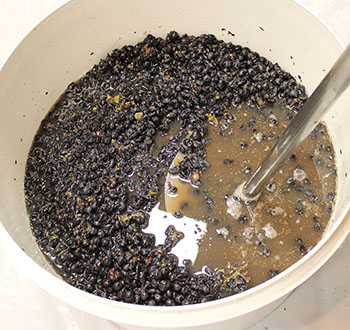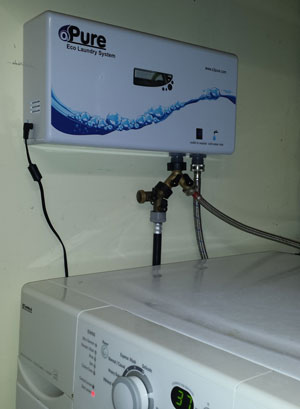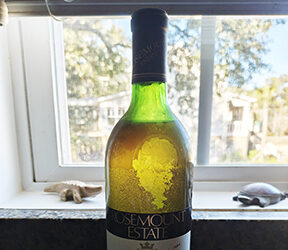Q
I have had numerous red wines throw off color as they are fermenting and right on through getting ready to bottle. Is this an acidity problem and how can I correct this?
Paul Stadler
New Freedom, Pennsylvania
A
Ever open a bottle of red wine you’ve lovingly saved for 20 years only to be disappointed as a brick-orange liquid followed by a brownish sludge falls into your glass?
The issue of color optimization and retention in red wines is a large and complicated one — I could probably write at least ten articles on the topic. The colored matter in almost all grapes is contained only in the skin, though the green or yellowish flesh can contain important color precursors and elements important to color retention like natural acids. The most basic thing to know is that some red grape varieties tend to have more or less color components and color precursors than others. Cabernet Sauvignon, for example, tends to have more (and more stable) color than Pinot Noir. So the first thing to contend with, whatever your grape or must chemistry, is the grape variety itself. In my experience the following grapes tend to have color-retention problems: Pinot Noir, Sangiovese, Tempranillo, Nebbiolo, and many hybrid varieties. Safer color-retaining bets include Syrah, Cabernet Sauvignon, Petit Verdot, Malbec, and Petite Sirah. Of course, if you really want to maximize color, you could try making red wine (or at least a small amount as a blender) from grapes of which the flesh is also red; Alicante Bouschet is often grown by large wineries just for that purpose. Be aware, however, that Alicante, at least in my experience, doesn’t produce the most charming table wines and is best used only as a blender. As you can see, your choice of initial grape really matters.
There are many things that can be done every step of the way in red winemaking to make the most of what Mother Nature has given your grapes. Be mindful that oxidation, whether microbial (metabolically), chemical (directly reacting with environmental oxygen), or enzymatic can degrade color and cause less than optimal conditions for the survival of colored compounds. My tips for optimizing and retaining maximum color in red musts and wine include:
• Pick before the grapes become overripe and raisined. This is more of an anecdotal tip from my 15 years making wine, but older, shriveled grapes, when made into wine, have many of their aroma and color compounds “pre-aged” by the sun and chemical breakdown. Additionally, acidity is lower, yeast nutrients depleted, and a host of microbes (yeast, mold, bacteria) may begin to grow on the grapes surface, not exactly conditions conducive to optimal winemaking.
• Minimize the time between field and fermenter. Oxidative and spoilage microbes can grow the longer the lag between picking and processing.
• Correct high pH (low acid) musts promptly. For red wines that will go through malolactic fermentations (which de-acidifies the must), I like to see initial pH no higher than 3.60. When in doubt, and if you lack equipment, if the must tastes at all like it lacks acid, I recommend adding 1 g/L before pitching yeast. Mix well. High pH conditions encourage spoilage microbe growth as well as make highly pigmented color compounds less stable.
• Ferment on a tannin or oak product to provide “sacrificial tannins.” You can try to bolster the amount of color you’ll be left with post-fermentation if you can provide your red ferment with additional tannin for oxygen to attack instead.Most home winemaking retailers sell an array of fermentation tannins for red wine.
• Use a fermentation enzyme specifically for color optimization. These are usually added after crushing and before pitching yeast. These enzymes help lyse the cell walls of the grape skins, releasing colored material and color precursor elements into the fermenting must. Always be careful of adding an enzyme too close to or too soon before or after an SO2 addition as an enzyme’s reactivity will be decreased by sulfur dioxide.
• During fermentation, punch down, pump over, or otherwise mix and agitate your must at least twice a day. Perhaps three times during the peak fermentation days.
• Ensure a healthy and complete fermentation. This means keeping pH, fermentation temperatures, and must nutrition within healthy ranges.
• Keep the wine on the skins for sufficient days. I usually press at dryness or a few days afterwards, with a 10–12 day fermentation being usual. If you have a quick, short fermentation (4 days or so) you may want to leave the wine on the skins a few more days to make sure you’re extracting enough color, making sure to keep stirring to minimize oxidative/microbial spoilage risks.
• Avoid oxygen during aging. Oxidation can turn pigments orange or brick red and encourage their precipitation. Keep containers topped up.
• Maintain adequate levels of free SO2 to serve as an antioxidant. Typically shoot for 30 ppm, but more if you have a high pH situation.
• Store wine away from light and heat. Light can affect color, so also don’t use clear bottles. Wine is ideally stored around 50–55 °F (10–13 °C). Warmer temperatures will speed up the condensation and oxidation of colored compounds.
Q
What are the steps for making a white Zinfandel wine? How long should I allow for skin contact, and is everything else the same as making a red Zin thereafter?
John Vigliotti
Temecula, California
A
Funny you ask this question as I’ve just now got three tanks full of 2016 Monterey Pinot Noir rosé fermenting in the winery. White Zinfandel, contrary to what some folks think, is a rosé of red Zinfandel grapes and not a unique variety all to itself. It was “invented” at Napa’s Sutter Home winery in 1975 when a batch of bled-off juice from a red Zinfandel fermentation failed to go dry. As the winemaker’ scratched their heads wondering what to do with thousands of gallons of sweet pink wine, they tasted it and decided it was pretty good. The marketing department got on board, naming the accident “White Zinfandel.” Consumers across the nation started to lap it up and a legend was born.
I don’t know how many cases of white Zinfandel are consumed in the United States each year but I know it’s a heck of a lot. Pooh-poohed as cheap plonk, I take a more charitable view of the brew as white Zinfandel can be a “gateway wine” for those new to the grape. Folks start with the sweet pink stuff but as their taste buds mature they start to gravitate towards other, more expensive products. A person who used to only drink margaritas and piña coladas is all of a sudden a wine drinker. As a commercial wine producer, I can definitely get behind that.
Part of white Zinfandel’s appeal, and that of any rosé for that matter, is that it’s crisp, refreshing, and easy to drink. There’s something about a pink beverage that kicks eons of cobwebby wine myths to the curb and it becomes fun rather than stuffy, casual rather than straight-laced. For those who are fans of the drier Provençal style of rosé, it can also be a wonderfully versatile food wine.
So aside from skin contact time, is making white Zin the same as making a red Zinfandel? The short answer is, “No way, rosé.” Just about every winemaking decision here is different as the end result for white Zin (lightly colored, refreshing, lighter in alcohol, slightly sweet) is just about the opposite of everything red. Put the emphasis on the “white” in white Zinfandel and you’ll be steered right every time. Here’s how:
• Pick grapes earlier than you normally would for a red wine: You want lower alcohol and more acid in your white Zinfandel to balance the residual sugar, so target Brix levels between 21–23.5. I look for a pH around 3.20–3.40.
• Press before fermentation, not after: Depending on how dark you want your color, increase or decrease skin contact time. One of the easiest ways for a home winemaker to make pink wine is to literally tread on the grapes with your feet in their picking container or containers (assuming it’s watertight) and letting the grapes sit for a little while. Monitor the color of the juices released until it’s to your liking, then press immediately. Keep in mind that you’ll lose a shade or two of hue during fermentation and aging, as well as by fining and filtering, so skew a teeny bit darker than you think you’ll want (this is especially true if you were working with a poor-color variety like Pinot Noir).
• Adjust acid as necessary to a higher level than a red wine: Don’t be afraid to add tartaric acid to get that pH down and the titratable acidity (TA) up. You want every mouthful to be refreshing and acid will help you get there.
• Choose a yeast to maximize fruity aromas: I like the RC212 yeast strain for rosé but other popular choices include BA11 and 71B.
• Ferment cool/cold: As opposed to a red wine fermentation, where you want temperatures high (up to 90 °F/32 °C) to help you extract color and tannin from the skins, here your goal is to preserve aroma and crispness. I like to ferment between 57–62 °F (14–17 °C) if possible.
• Arrest the fermentation or add sugar later: You’re going to want a little residual sugar in this wine, perhaps 0.30–3.0%, depending on your tastes. Most white Zinfandels are perceptibly sweet, though I like mine a little drier. This can be achieved by arresting the fermentation (using chilling, an SO2 addition, and filtration), though for home winemakers it’s easier and more foolproof to add sugar or grape concentrate and then potassium sorbate to inhibit renewed fermentation in the bottle.
• Don’t allow malolactic fermentation (MLF) to occur: You want to keep acid, not lose it, remember? Also, when I’ve had rosés going through any kind of MLF, I experienced color that went from a pinky-purple (a hallmark of white Zinfandel) to pinky-orange. Adjust free SOsub>2 to around 30 ppm immediately after primary fermentation to retard MLF.
• Heat and cold stabilize: Just like a white wine, white Zin looks best when it’s sparklingly clear with no sediments. I always recommend adding bentonite for protein stability and then doing what you can to cold stabilize.
• Adjust residual sugar if needed: You will want a little residual sugar in this wine and it’s tough to give a percentage goal when tastes differ so much. I like mine drier so I tend to go for around 0.50–0.75% while others like 3% or more. It’s also easier to add sugar later, right before bottling (sterile filter first!) rather than try to stop the fermentation right at that perfect balance point. You can add table sugar but white grape concentrate is also an option.
• Bottle with elevated free SO2: To preserve the color and freshness over time, I’d recommend bottling rosés with free SO2 of at least 30 ppm. This is dependent on the pH of your wine, so to get a more precise free SO2 target use a sulfite calculator like the one at www.winemakermag.com/sulfitecalculator.
• Drink within a year: While well-made red Zinfandels can age for years and possibly decades, pink wines have a shorter, more ephemeral shelf life.







